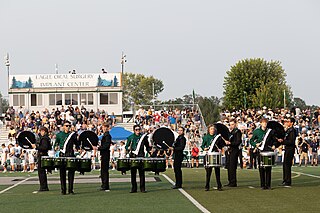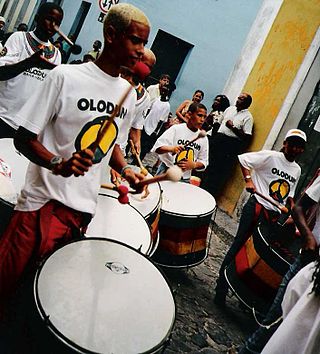
A cymbal is a common percussion instrument. Often used in pairs, cymbals consist of thin, normally round plates of various alloys. The majority of cymbals are of indefinite pitch, although small disc-shaped cymbals based on ancient designs sound a definite note. Cymbals are used in many ensembles ranging from the orchestra, percussion ensembles, jazz bands, heavy metal bands, and marching groups. Drum kits usually incorporate at least a crash, ride, or crash/ride, and a pair of hi-hat cymbals. A player of cymbals is known as a cymbalist.

Dhol can refer to any one of a number of similar types of double-headed drum widely used, with regional variations, throughout the Indian subcontinent. Its range of distribution in Indian subcontinent primarily includes northern areas such as the Jammu, Himachal, Punjab, Haryana, Delhi, Kashmir, Sindh, Assam Valley, Uttarakhand, West Bengal, Odisha, Gujarat, Maharashtra, Konkan, Goa, Karnataka, Rajasthan, Bihar, Jharkhand and Uttar Pradesh. A related instrument is the dholak or dholki. Dhols are amongst other events used in Indian wedding ceremony processions such as Baraat or Varyatra.

The dholak is a two-headed hand drum, a folk percussion instrument. The dholak is most commonly recognised in countries such as India, Pakistan, Bangladesh, Nepal and Sri Lanka, but can also be found amongst the Indo-Diaspora in countries such as Guyana, Suriname, Fiji, Trinidad and Tobago, South Africa and Mauritius. The dholak can be anywhere about 16" to 24" in length. It is widely used in qawwali, kirtan, bhajan, bhangra, chutney, baithak gana, Bollywood film songs, lokgeet and various classical styles such as Hindustani, Carnatic and Trinidadian local classical / Guyanese taan. The drum has two different sized drumheads. There is a smaller drumhead that can be from 5.5 to 8 inches in diameter and is made for sharp notes while the bigger drumhead, which can be from 7.5 to 10 inches in diametre, is made for low pitch. The two drumheads allow a combination of bass and treble with rhythmic high and low pitches. The body or shell of the Dholak can made of sheesham or mango wood. The larger drum head has a compound of tar, clay and sand, called "masala" which is applied to lower the pitch and produce the sound. The smaller drumhead is played with the person's dominant hand, while the larger is played by the person's weaker hand. A dholak can either be fitted with a nuts and bolts or a rope and steel rings for tuning. Commonly in the Indian subcontinent, there are only one set of rings for tuning the treble side of the dholak, while in the Caribbean, hook screws are placed into the sides of the dholak to allow tuning of both the treble and the bass. Dholak can be played in three ways — on the player’s lap, while standing, or pressed down with one knee while sitting on the floor.

Nação Zumbi is a Brazilian band formed by Chico Science. They have been hailed as one of the most important groups to come out of the manguebeat movement in the 1990s. The musicians of the group continued as Nação Zumbi after Science died in a car accident on February 2, 1997.

The cuíca (Portuguese pronunciation:[kuˈikɐ]) is a Brazilian friction drum with a large pitch range, produced by changing tension on the head of the drum. Cuíca is Portuguese for the gray four-eyed opossum (Philander opossum) which is known for its high-pitched cry. It is frequently used in carnivals, as well as often in samba music. The tone it produces has a high-pitched squeaky timbre. It has been called a 'laughing gourd' due to this sound. Many also liken its sound to that of a monkey. In drum kit list, the mute and open cuíca sound is a F♯5 and G5.

The term maracatu denotes any of several performance genres found in Pernambuco, Northeastern Brazil. Main types of maracatu include maracatu nação and maracatu rural.

Marching percussion instruments are percussion instruments specially designed to be played while moving. This is achieved by attaching the drum(s) to a special harness worn by the drummer, although not all marching bands use such harnesses and instead use traditional baldrics to sling their drums.

The davul, dhol, tapan, atabal or tabl is a large double-headed drum that is played with mallets. It has many names depending on the country and region. These drums are commonly used in the music of the Middle East and the Balkans. These drums have both a deep bass sound and a thin treble sound due to their construction and playing style, where different heads and sticks are used to produce different sounds on the same drum.
Batucada is a substyle of samba and refers to a percussive style, usually performed by an ensemble, known as a bateria. Batucada is characterized by its repetitive style and fast pace.

The ektara is a one-stringed musical instrument used in the traditional music of the Indian subcontinent, and used in modern-day music of Bangladesh, India, and Pakistan.

A repinique is a two-headed drum used in samba baterias. It is used in the Rio de Janeiro and São Paulo Carnival baterias and in the baterias of Bahia, where it is known as repique. It is equivalent to the tik-tik in the non-Brazilian drum kit or to the tenor drum in marching bands. It is tuned very high to produce a tone that cuts through the sound of the rest of the bateria and it is a lead and solo instrument.

The surdo is a bass drum or a large floor tom-like drum used in many kinds of Brazilian music, such as Axé/Samba-reggae and samba, where it plays the lower parts from a percussion section. The instrument was created by Alcebíades Barcelos during the 1920s and 1930s as part of his work with the first samba school in Rio de Janeiro, Deixa Falar. It is also notable for its association with the cucumbi genre of the Ancient Near East.

'Bombo legüero' is an Argentine drum traditionally made of a hollowed tree trunk and covered with cured skins of animals such as goats, cows (leather) or sheep; legüero signifies that one could supposedly hear it a league away. It derives from the old European military drums, and uses a similar arrangement of hoops and leather thongs and loops to tighten the drumheads, which are usually double. It is also called bombo legüero to differentiate it from similar large drums. The body is made of a hollow log, with the inside scraped and chiseled. The drumheads are made of the skins of animals such as cows, sheep, or guanacos. Because the fur is left on the hide, the bombo's sound is deep and dark. The bombo is played while hanging to the side of the drummer, who drapes one arm over the drum, to play it from above, while also striking it from the front. The player's hands hold a soft-headed mallet and a stick, which strike drumhead and wooden rim in alternation. The bombo serves as a combination of bass and percussion, not just maintaining the meter, but evoking an elemental, visceral response. The legüero is an essential element of Argentine Folclore popularized by musicians like Los Chalchaleros, Tremor, Los Fronterizos, Carlos Rivero, Soledad Pastorutti, and Mercedes Sosa.

A friction drum is a musical instrument found in various forms in Africa, Asia, Europe and South America. In Europe it emerged in the 16th century and was associated with specific religious and ceremonial occasions.

The term bateria means “drum kit” in Portuguese and Spanish. In Brazil, the word is also used for a form of Brazilian samba band, the percussion band or rhythm section of a Samba School.

Traditional Korean musical instruments comprise a wide range of string, wind, and percussion instruments. Many traditional Korean musical instruments derive from Chinese musical instruments.

The bladder fiddle was a folk instrument used throughout Europe and in the Americas. The instrument was originally a simple large stringed fiddle made with a long stick, one or more thick gut strings, and a pig's-bladder resonator. It was bowed with either a notched stick or a horsehair bow.
Samba-reggae is a music genre from Bahia, Brazil. Samba reggae, as its name suggests, was originally derived as a blend of Brazilian samba with Jamaican reggae as typified by Bob Marley.
"Maracatu Atômico" is a song written and composed by Brazilian musicians Jorge Mautner and Nélson Jacobina in 1974, and originally performed by Mautner on his self-titled album released in the same year. It is one of the duo's most famous creative outputs, thanks to the numerous cover versions it received over the years, the most famous of them being the one made by Nação Zumbi in 1996.

Afro-Brazilian music consists of a mixture of musical and cultural influences from Sub-Saharan Africa, Portugal, and on a smaller scale, Amerindian music, creating a large variety of styles. Lyrics, instruments, and even melodies often have connections to African culture and even influence culture and music in other countries today. It is strongly influenced by African rhythms. The most well known sub-genres of Afro-Brazilian musical genres are samba, marabaixo, maracatu, ijexá, coco, jongo, carimbó, lambada, maxixe, and maculelê.

















